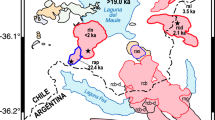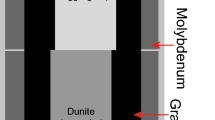Abstract
Fe-rich tholeiitic liquids are preserved as chilled pillows and as the chilled base of a 27 meter thick macrorhythmic layer in the Pleasant Bay mafic-silicic layered intrusion. The compositions of olivine (Fo1) and plagioclase (An13−8) in these extremely fine grained rocks suggest that they represent nearly end stage liquids that formed by fractionation of tholeiitic basalt. Their major element compositions (∼17.5 wt% FeOT and 54 wt%SiO2) closely resemble highly evolved glasses in the Loch Ba ring dike and some recent estimates of end-stage liquids related to the Skaergaard layered intrusion, and are consistent with recent experimental studies of tholeiite fractionation. Their trace element compositions are consistent with extensive earlier fractionation of plagioclase, olivine, clinopyroxene, ilmenite, magnetite and apatite. The mineral assemblage of the chilled rocks (olivine, clinopyroxene, quartz, ilmenite and magnetite), apatite saturation temperatures, and very low Fe3+/Fe2+indicate conditions of crystallization at temperatures of about 950 °C and f O 2 about two log units below FMQ. Cumulates that lie about 3 meters above the chilled base of the macrorhythmic layer contain cumulus plagioclase, olivine, clinopyroxene, ilmenite, apatite and zircon. This mineral assemblage and the Fe-Mg ratio in clinopyroxene cores suggest that this cumulate was in equilibrium with a liquid having a composition identical to that of the chilled margin which lies directly beneath it. The high FeOT and low SiO2 concentrations of this cumulate (23.3 and 45.8 wt%, respectively) are comparable to those in late stage cumulates of the Skaergaard and Kiglapait intrusions. This association of a chilled liquid and cumulate in the Pleasant Bay intrusion suggests that late stage liquids in tholeiitic layered intrusions may have been more SiO2-rich than field-based models suggest and lends support to recent experimental studies of tholeiite fractionation at low f O2 which indicate that saturation of an Fe-Ti oxide phase should cause FeOT to decrease in the remaining liquid.
Similar content being viewed by others
Author information
Authors and Affiliations
Additional information
Received: 17 January 1997 / Accepted: 10 June 1997
Rights and permissions
About this article
Cite this article
Wiebe, R. Fe-rich tholeiitic liquids and their cumulate products in the Pleasant Bay layered intrusion, coastal Maine. Contrib Mineral Petrol 129, 255–267 (1997). https://doi.org/10.1007/s004100050336
Issue Date:
DOI: https://doi.org/10.1007/s004100050336




